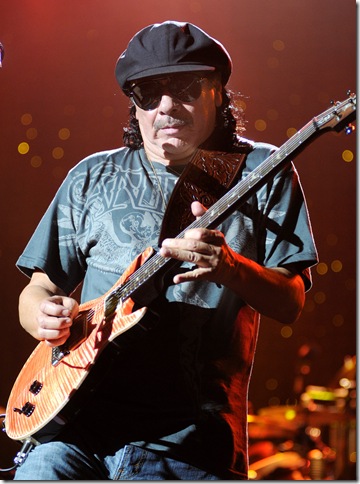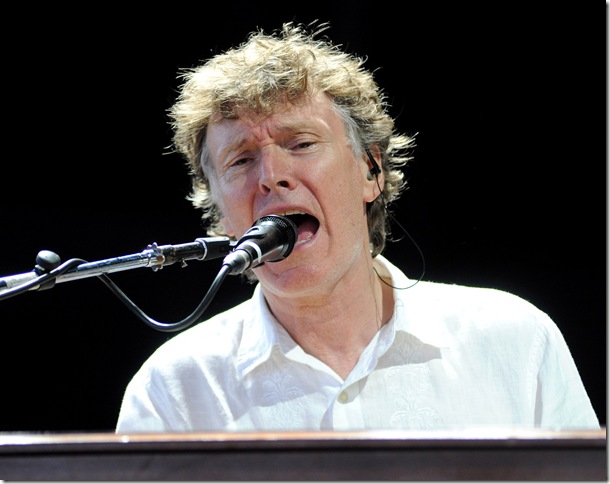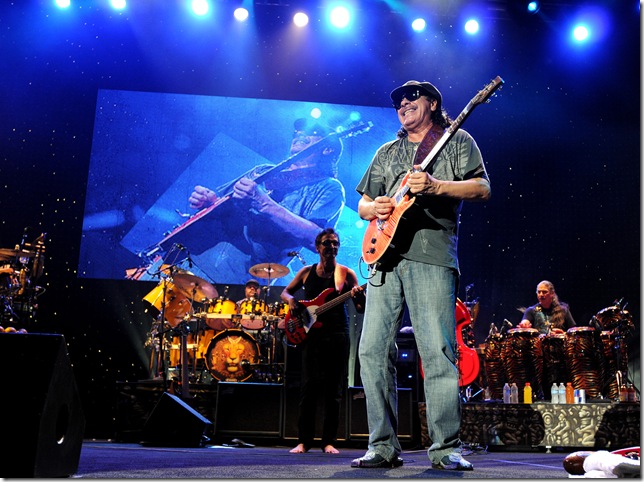Both were boy wonders. Both were performing in public before they reached puberty. Both have kept the fires burning, enthralling, inspiring and enlightening audiences for more than five decades.
But perhaps Sunday’s show at Cruzan Amphitheatre in West Palm Beach explains why the Rock & Roll Hall of Fame has inducted Carlos Santana as an individual artist, but Steve Winwood only as a member of Traffic.
For Winwood, it was a night of “perhapses.”
Perhaps the sound mix was uneven. No. The sound was uniform throughout the shed.
Perhaps it was an unfamiliar song here or there. No. “They’ve been playing the same set all tour,” a sound tech said.
Perhaps he was road-weary. Possible. His 2010 touring schedule began Feb. 9 in Durham, N.C., with four stateside dates, broke for three months, then jumped to Europe for 16 May through mid-June well-received shows with Eric Clapton. After one solo show in Chicago on June 26, he hit the heartland as opener for Santana.
Twenty-three shows in 33 days.
Was he tired? He didn’t appear to be. At age 62, he seems fit, the ideal image of a boy wonder half a century later.
Perhaps it was his band. Five players including Winwood. Competent, but hardly inspiring. Perhaps Steve was deferring to the lead act. Didn’t want to show up his elder.
After all, so many times in his career he was not the dominant force. His first gig, at age 15, was in the Spencer Davis Group. Traffic was a joint effort, and with the likes of Dave Mason and Jim Capaldi, egos were bound to clash. Longevity wasn’t in the cards. Then came Blind Faith, a one-album wonder with Clapton and Ginger Baker, back to Traffic with Capaldi for its dominant years.
Nothing Sunday night was dominant. With its flute interludes, the opener, Secrets, conjured up some of early Traffic’s jazzy twists, and Dirty City, with Winwood on guitar, suggested more edge which built as the band ripped into Can’t Find My Way Home. But then the Low Spark of High-Heeled Boys needed a highlight. Too reserved.
Going trio, Winwood swapped his beloved Hammond B-3 for a Stratocaster and showed some fire in his solo on Dear Mr. Fantasy, but the song still seemed to drag. Then came a rousing , pumping, this-is-what-we expect-from-Steve-Winwood Gimme Some Lovin’. Alas, the set was over.
As fan “sponge bob” wrote on Winwood’s website Monday morning: “Steve, Steve, Steve, you have fallen asleep at the wheel. I was so dissapointed (sic) in your show; it was like a jam session! Just terrible.”
It didn’t help that, unlike Tampa the night before, when Winwood and band joined Santana and band for Marvin Gaye’s Right On, the fans were treated to no what-if fireworks Sunday.
No sweet taste. No foul taste either. Just: Huh? The music offered no depth, no power, no subtlety – a monaural memory in a high-def world. If this was earth music, then Winwood and Co., are in the middle of a drought.
Back in the VIP area during intermission, UpShot, a local band that struggles for every gig it can get in a lean market, sounded better on its covers of the likes of Brown-Eyed Girl.
We have to wonder about Carlos Santana, too. Not about his talent or his music, but about what might have happened to him had the nation been embroiled so deeply in the immigration debate half a century ago when his family moved from Tijuana to San Francisco. Fortunately, he didn’t have to scale barbed wire or swim a river, and in 1965, the same year he graduated high school, he became a U.S. citizen.
Actually, Santana is more a citizen of the world, as he expressed after opening with a powerful, energetic Yaleo: “We are very grateful, appreciative. This is what Martin Luther King was talking about: unity, harmony, respect for one another.”
Then BOOM! They were off, with the political Maria Maria, vocalists Andy Vargas and Tony Lindsay going back and forth:
See mi y Maria on the corner
Thinking of ways to make it better
In my mailbox there’s an eviction letter
Somebody just said see you later
Then came the horns (Bill Ortiz and Jeff Cressman) on Foo Foo, the salsa of Corazon Espinada, and Dennis Chambers’ exhausting drum solo, all enhanced by a dramatic light show and three video screens that served to amplify Santana’s world view. No where was it more evident than with the African tribal dancers on Santana’s first hit, Jingo, with musical emphasis to the percussion of Karl Perazzo and Raul Rekow and Freddie Ravel’s organ. Add Miami-raised Tommy Anthony on guitar and backing vocals and Benny Rietveld on bass and you have the complete package.
They go bluesy on Singing Winds, Crying Beasts, then have the crowd dancing in the aisles with Evil Ways and A Love Supreme. Cream’s Sunshine of Your Love offered a taste from the new album, Guitar Heaven: The Greatest Guitar Classics of All Time (due Sept. 21) while Smooth/Dame tu amor recalled Ultimate Santana, the first such guest-star venture in 2007.
The band is blessed with energy; every member wants to cook; every member, however, knows he’s in a band and thus part of the team.
With only one album, Santana first played South Florida at the Miami Rock Festival at Miami-Hollywood Speedway Park in what is now Pembroke Pines in late December 1969. Not much survives, no reviews, no set lists. By contrast, Woodstock is seared into the rock fan’s memory and was rekindled at Cruzan with a triptych video that began with the “Woodstock chant” and continued in perfect synch on stage with Soul Sacrifice. Hits from album No. 2, Abraxas, followed: Black Magic Woman/Gypsy Queen, Oye Como Va.
Into the Night, another Ultimate cut was followed by the Chambers Brothers’ Love Peace and Happiness that segued into Freedom.
Thus a tale of two concerts: Winwood, full of promise but failing to fulfill, and Santana, leaving the audience screaming for more but satisfied. Such is rock ‘n’ roll.


